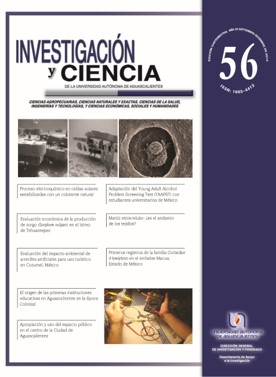Environmental impact of artificial reefs for tourism in Cozumel, Mexico
DOI:
https://doi.org/10.33064/iycuaa2012564026Keywords:
environmental impact, artificial reef, tourism, Cozumel, sustainabilityAbstract
Coral reefs distribution around the planet is uneven. Only some oceans can support such ecosystem that is the most complex and diverse on earth, but also one of the most fragile to global warming and environmental stress associated to tourism. Coral reefs in the Caribbean and in Cozumel, Mexico, are a clear example of environmental loss due to excessive tourism and extreme tropical
storms. Facing such a challenge, the government of Quintana Roo and the Mexican Federal Agency for Science and Technology promote the protection of Cozumel’s coral reefs, through artificial reefs that within a sustainable framework, increase diving alternatives, help business of local diving shops, promote conservation and reduce tourist visits to the natural reefs in the neighboring marine protected.
Downloads
Metrics
References
• ÁLVAREZ-FILIP, L., Efecto de los huracanes Emily y Wilma en el Parque Nacional Arrecifes de Cozumel. Biodiversidad acuática de la Isla de Cozumel (pp. 361-372). UQROO México, 2008.
• BARKER, N.; ROBERTS, C.M., Attitudes to and Preferences of Divers towards Regulation. In: New Frontiers in Marine Tourism: Diving Experiences, Sustainability, Management. Amsterdam: Elsevier, 2008.
• BOHNSACK J.A. Are high densities of fish at artificial reefs the result of habitat limitation or behaviroral preference? Bulletin of Marine Science, 44: 631-645, 1989.
• FITZHARDINGE, R.C.; BAILEY-BROCK, J.H., Colonization of artificial reef materials by corals and other sessile organisms. Bulletin of Marine Science, 44: 567-579, 1989.
• JORDAN-DAHLGREN E; RODRÍGUEZ, M.R., The Atlantic Coral Reefs of Mexico. In: Latin America Coral Reefs (pp. 131-158). Amsterdam: Elsevier, 2003.
• KOSTYLEV, V.E.; WILLIAMS, G.A.; MAK, Y.M., Macrofaunal community structure and habitat complexity: the importance of substratum complexity in assessing rocky shore communities. Spatial heterogeneity and habitat complexity affecting marine litoral fauna. PhD thesis, Göteborg University, Alemania, 1996.
• KRAMER P.A.; KRAMER, P.R., Ecological Status of the Mesoamerican Barrier Reef: impacts of Hurricane Mitch and 1998 coral bleaching. Final report to the World Bank. RSMAS, University of Miami, 2000.
• LARKUM, A.W.D., The primary productivity of plant communities on coral reefs. In: Perspectives on Coral Reefs (pp. 221-230). Townsville: Australian Institute of Marine Science,1983.
• LUKENS, R.R.; SELBERG, C., Guidelines for Marine Artificial Reef Materials. Atlantic and Gulf States Marine Fisheries Commissions. Estados Unidos de América:.Ocean Springs, MS, 2004.
• LUNA, L.; FRANK, C.; BRUCE, H.; BASLEY, J., A Procedure for Evaluating Environmental Impact. Geological Survey Circular, 645. Departamento del Interior, Estados Unidos de América, Washingt, 1971.
• MARTÍNEZ, C.; GALLEGOS, O., Tendencias del turismo de cruceros al inicio del siglo XXI. Memorias in extenso del 9° Seminario de Turismo y Sustentabilidad y 4° Congreso de Gastronomía (pp. 171-183). Universidad del Caribe. México, 2011.
• NIM IV, C.J., The political ecology of environmental change and tourist development in Cozumel, Mexico. Thesis Master in Geography. Miami University. Estados Unidos de América, 2006.
• PALAFOX A.; ZIZUMBO, L. V., Distribución territorial y turismo en Cozumel Estado de Quintana Roo, México. Gestion Turística, 11: 69-88, 2009.
• PRECHT, W.F., Coral reef restoration handbook. USA:CRC Press, 2006.
• RILOV, G.; BENAYAHU, Y., Rehabilitation of coral reef-fish communities: The importante of artificial – reef relief to recruitment rates. Bulletin of Marine Science, 70: 185-197, 2002.
• SALE P.E., CoraI Reef: Fishes Dynamics and Diversity in a Complex Ecosystem. San Diego, California: Academic Press Inc., 2002.
• SANTANDER, L.C.; PROPIN, E., Impacto Ambiental del Turismo de Buceo en Arrecifes de Coral. Cuadernos de Turismo, 24: 207-227, 2009.
• SEAMAN, W., Does the level of design influence success of an artificial reef? In: Proceedings of the 1st Conference of the European Artifical Reef Research Network (pp. 26-30). Ancona, Italia, 1996.
• SEAMAN, W.; SPRAGUE, L.M., Artificial Habitat Practices in Aquatic Systems. Artificial Habitats for Marine and Freshwater Fisheries (pp. 1-29). San Diego, California: Academic Press, Inc., 1991.
• SEGRADO R.; PALAFOX, A.; ARROYO, L., Medición de la Capacidad de Carga Turística de Cozumel. El Periplo Sustentable, 13: 33-61, 2008. De: http://www.uaemex.mx/plin/psus/rev13/articulo_02.pdf. Recuperado el 26 de mayo de 2012.
• TOWNSEND, C., Dive Tourism, Sustainable Tourism and Social responsibility. In: New Frontiers in Marine Tourism: Diving Experiences, Sustainability, Management. Amsterdam: Elsevier, 2008.
• WALKER B. K.; HENDERSON B.; SPIELER, R.E., Fish assemblages associated with artificial reefs of concrete aggregates or quarry stone offshore Miami Beach, Florida, USA. Aquat. Living. Resour, 15: 95-105, 2002.
• WATHERN, P., Environmental Impact Assesment: theory and practice. Londres: Routledge, 1990.
Downloads
Published
How to Cite
License
Copyright (c) 2012 Luis Carlos Santander, Marilú López Mejía, Luis Manuel Mejía Ortiz, Oswaldo Gallegos Jiménez

This work is licensed under a Creative Commons Attribution-NonCommercial-ShareAlike 4.0 International License.
Las obras publicadas en versión electrónica de la revista están bajo la licencia Creative Commons Atribución-NoComercial-CompartirIgual 4.0 Internacional (CC BY-NC-SA 4.0)









